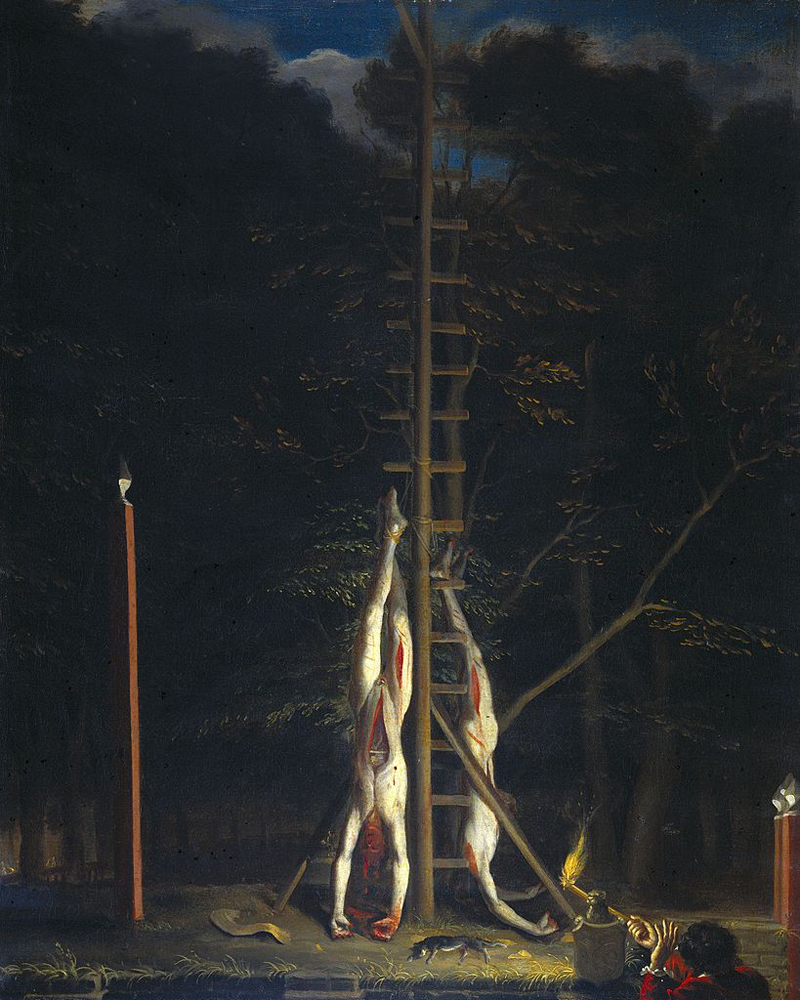There’s a meme making the rounds about how the Dutch lynched and ate their prime minister back in 1672 which is, alas, true. It also resulted in what has to be the creepiest Flemish Golden Age painting ever, “The Corpses of the DeWitt Brothers” by, it’s assumed, Jan De Baen, who had painted both DeWitts in life. You can see where steaks had been sliced from the shoulders and thighs, and how they’d been gutted and disemboweled in the process of getting at the liver. For some reason the liver is almost universally the gourmand’s organ of choice for humiliation by eating, whether by warring tribes in the New Guinea mountains or in the streets of Amsterdam in the Age of Rembrandt or by elite Japanese officers selectively devouring their prisoners in the Second World War. Devouring the heart ripped from a living man’s rib cage was certainly more dramatic but much less gastronomic. But that is probably a newer tradition, indeed one meaningless without the concept of a soul, which is what you are eating when you eat a man’s heart. A man’s soul, his spirit, his immortality. But eating a man’s liver requires only knowledge of what’s edible, indeed delectable, inside freshly killed prey. There is nothing so dehumanizing as reducing a human to a collection of food stuffs. It originated not as an act of humiliation but ordinary hunting. We once ate each other regularly. In times of stress we still might, though we did so more in ages past. It’s a tradition so universal that it might go back hundreds of thousands of years. It might even have a niche deep in our human DNA. Civilization’s aversion to cannibalism has been slowly built up over thousands of years and reinforced with layers of religion and law and tradition and mores. Otherwise we might be eating people the way we eat cattle. Perhaps our overwhelming success as social animals has something to do with the fact that we stopped hunting each other for food. We still hunt and kill other humans, but almost never for meat. Civilization does not work if we eat people regularly. There is not one civilization that did so. Not even when human sacrifice reached vast proportions, like among the Aztec during their holier months, was eating parts of people more than a priestly ritual.
We have such an enforced aversion to cannibalism that we do not even eat our dead, but rather let all those perfectly good steaks and sweetmeats rot away. It makes no sense, protein wise. Some very hungry people will think it makes no sense during times of intense famine when cannibalism crops up, though when discovered the cannibals typically are dispatched summarily, like rabid dogs. Undetected surviving cannibals do not continue eating human flesh once the famine is over. Or usually they don’t. History is full of disturbing exceptions. Perhaps the desire to eat human meat lies deep within us. And there does seem to be a latent desire to eat a person’s liver. It is good for the digestion, a Japanese general explained after eating a freshly slaughtered American pilot’s liver in 1945. It was fresh (the garrison’s surgeon did the cutting), cooked to perfection and served on a bed of rice with vegetables and a fine sake. Apparently there is something special, indeed healthy, about eating a humiliated man’s liver. The transcripts of the war crimes trial–the general’s digestion may have improved, but he hanged for it later–reveal nothing behind his notion that eating a man’s liver was good for the digestion. A bit of folk wisdom, perhaps. Maybe some ancient magic.
In the case of Johan de Witt and his brother Cornelius (both anti-monarchist republicans and supporters of religious tolerance), the two were cold bloodedly murdered one midsummer night by monarchist militia men and their bodies left to the reactionary Calvinist mob in the square. The scene quickly degenerated into an orgiastic mob, but one very orderly and Dutch. The bodies were not ripped to pieces, a not uncommon fate of Byzantine emperors and Roman martyrs (a tradition that nearly caught up with Benito Mussolini in 1945, who was spared the ultimate indignity when soldiers came upon the scene and kept his battered corpse intact ). Rather they were quickly hung up on a nearby gibbet in order to slice them up to get at their livers. From the painting it appears that professionals were called in, the local Calvinist butcher perhaps. It’s not clear how the livers were partaken. Served up fresh and raw and passed among the crowd who took a nibble before passing it along? Or divided into delicate slices and distributed for home cooking? History does not tell. No one else died, though, nothing was burned, and by nightfall the streets were empty and the corpses of the brothers hung, naked and mutilated and ghostly white by the light of the moon. It must have been an irresistible scene to a painter, though you can tell, by the clumsier details–the cat, or those hands a little too large on the man holding the torch–that he hurried to get the image down on canvas, like this was no place for an artist, not with the smell of the mob’s work still fresh in the air, sweet, like rotting meat.
Johan De Witt was an accomplished mathematician, by the way. But there was an anti-intellectual mood in Holland that year, and being a mathematician probably only helped to doom him.


I love History and was surprised i never heard of this. Tx for sharing☺
LikeLike
Spent my entire career in art history. Gotta’ admit, this is a new one for me. Thank you for unearthing this … well, “gem” isn’t quite the right word.
LikeLike
Watch this movie for context:https://www.imdb.com/title/tt2544766/
LikeLike
Thx, I definitely will. Never heard of this. Very cool.
LikeLike